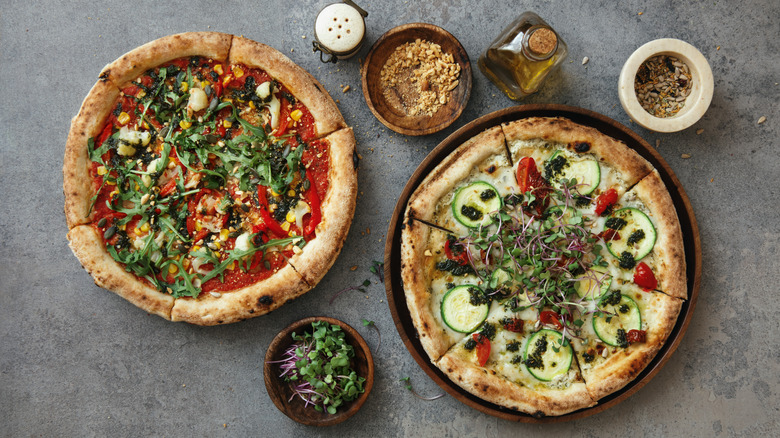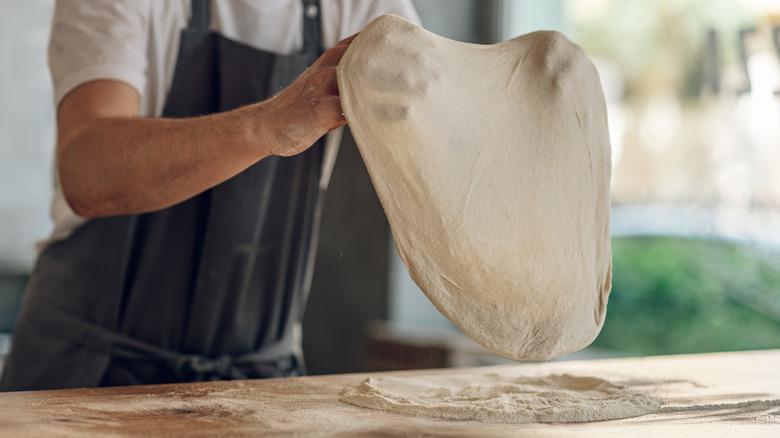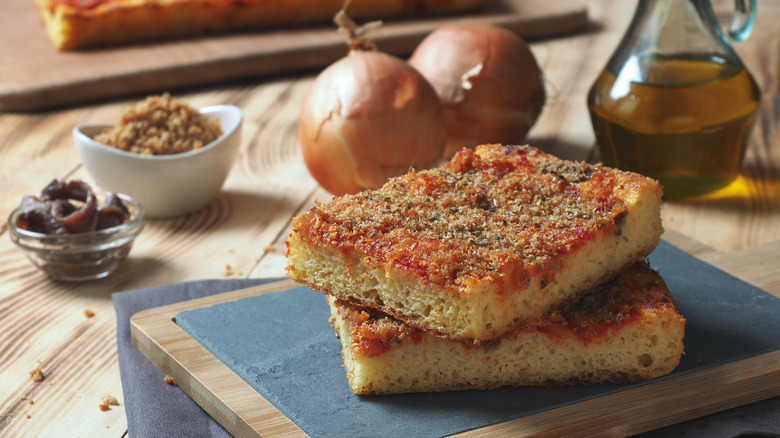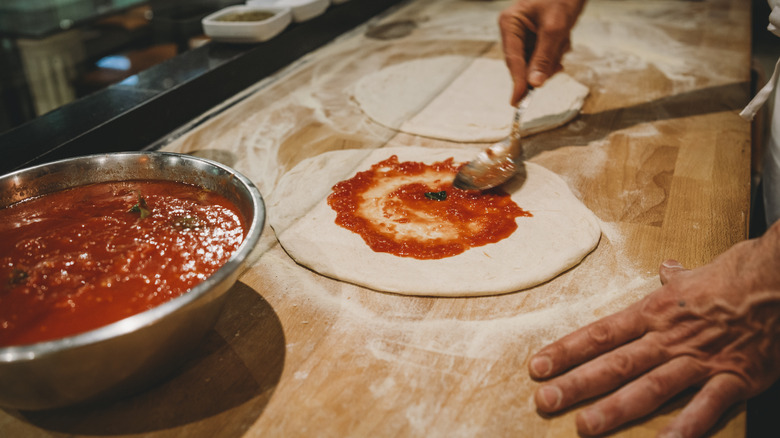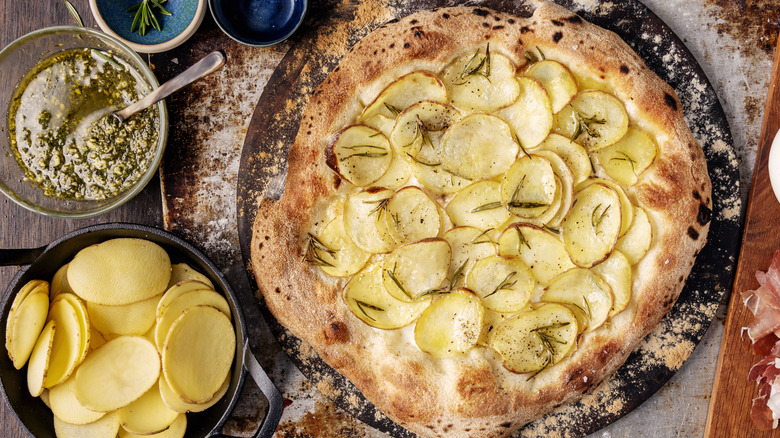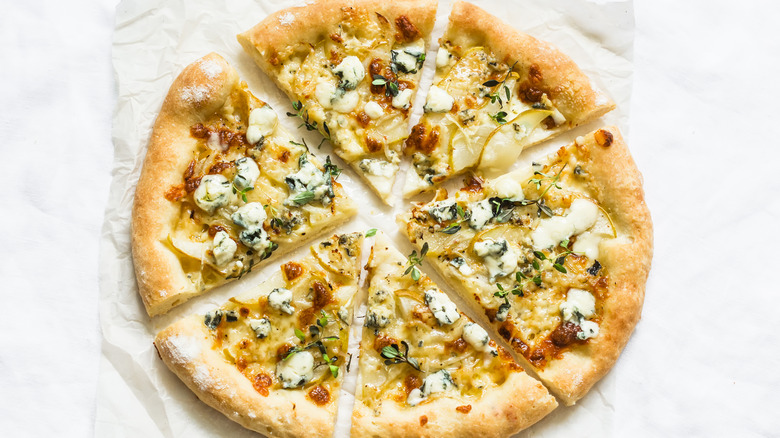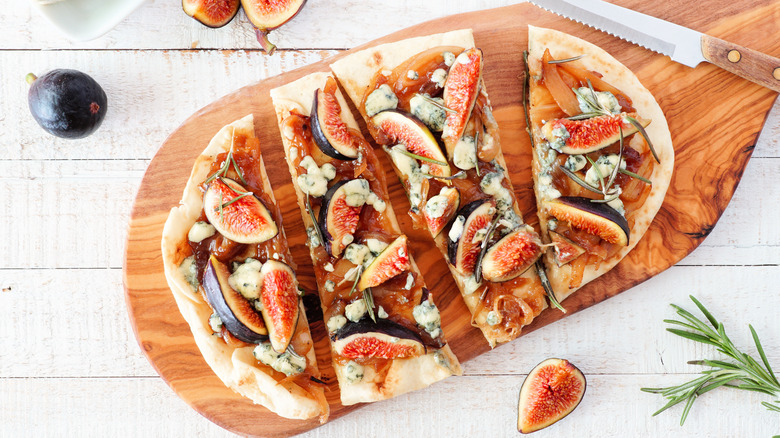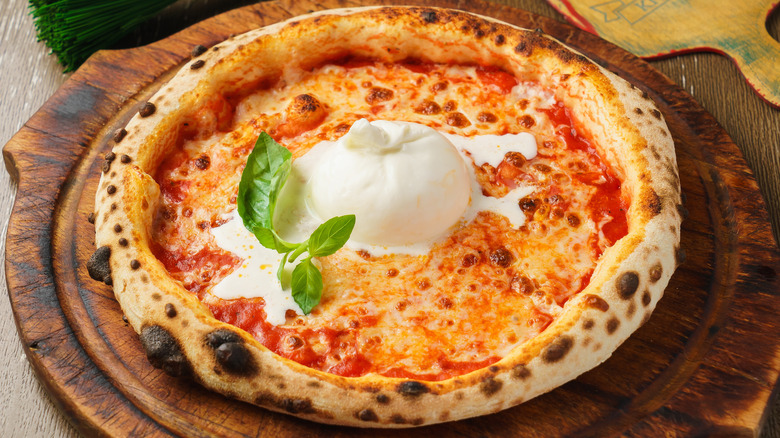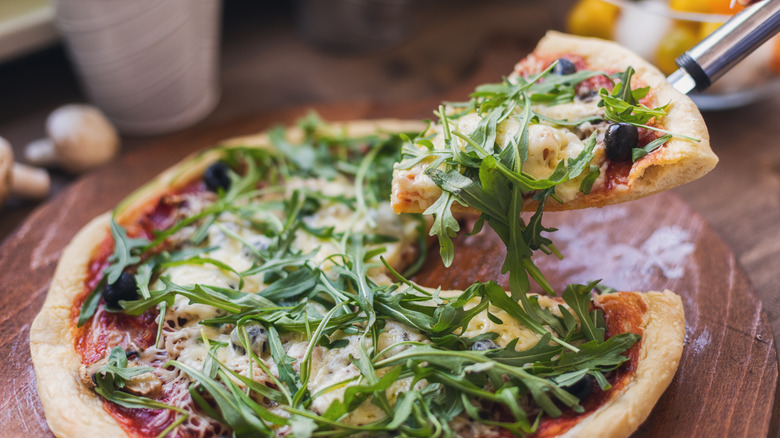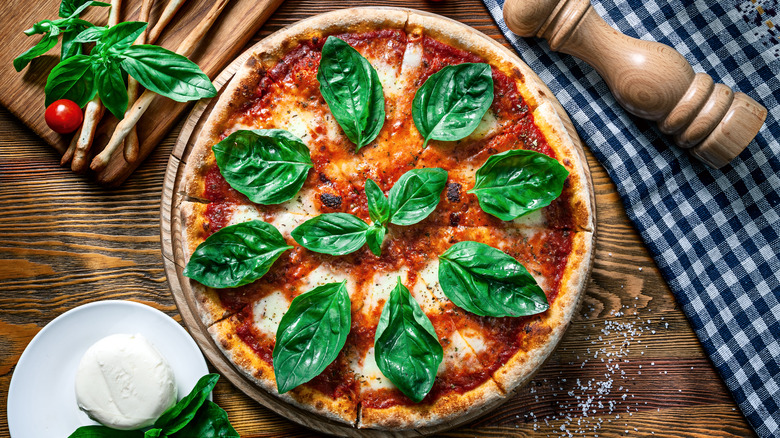12 Ways To Upgrade Homemade Pizza
If you've ever found yourself craving a slice of pizza perfection that goes beyond the ordinary, you're in for a treat. Homemade pizza has its charms, but why settle for the mundane when you can elevate your pizza game to extraordinary heights? We'll delve into the techniques, ingredients, and culinary secrets that will redefine your pizza-making experience, making your pies better than ever.
From crust to toppings, each element of your pizza creation is an opportunity to infuse creativity and elevate your culinary prowess. We'll explore dough varieties that you may not have tried or realized you could achieve at home, setting the foundation for a pizza that's nothing short of artisanal. No more settling for lackluster store-bought crusts — it's time to make your dough the star of the show.
But the adventure doesn't stop there. Our exploration extends to an array of sauces, cheeses, and toppings that will make your pizza stand out from the crowd. Whether you're a fan of classic Margherita or like something more adventurous, there's a world of possibilities waiting for you. Sure, you could get on your phone and order from your local pizza parlor with a few taps, but with these 12 ways to upgrade homemade pizza, your own creations will be impossible to resist.
1. Make your dough from scratch
The road to the perfect pizza begins with the heart of the pie: the dough. While it might be tempting to grab a premade, frozen dough from the grocery store for convenience, taking the extra step to craft your own dough is totally worth it. Making your own pizza dough isn't just about the satisfaction of creating something from scratch; it's about achieving a level of freshness and flavor that premade doughs can't match.
Homemade dough allows you to control the quality of ingredients, ensuring that each bite is second to none. Flour, water, yeast, and a pinch of salt — these basic components come together like magic, creating a canvas for your pizza dreams. The texture is where homemade dough truly shines. Forget the uniformity of store-bought options; with your own dough, you have the power to customize the thickness and crispiness according to your preferences. You can achieve that perfect balance between a crispy outer layer and a delightfully chewy inside — a feat that is often elusive with frozen alternatives.
The fact is that frozen dough from the grocery store just can't touch homemade pizza dough. Some frozen doughs are downright bad, but even the good ones lack the subtle complexities that come from the fermentation process of pizza dough made from scratch. Homemade dough has a depth of taste that transcends the one-dimensional experience of store-bought counterparts.
2. Experiment with different pizza doughs
Embarking on a pizza-making adventure at home opens up a world of dough possibilities, each with its unique character and flair. The beauty of crafting your pizza dough lies in the versatility to explore diverse styles that cater to your taste preferences. Let's take a flavorful tour through some iconic pizza doughs that you can easily master in your kitchen.
First up, the quintessential New York-style pizza dough. Known for its thin, foldable slices with a slight crispiness, New York-style dough strikes a balance between chewy and tender. There's also Neapolitan pizza dough, a nod to the birthplace of pizza. Characterized by a thin, soft center and a beautifully puffed, leopard-spotted crust, Neapolitan dough is a simple mix of flour, water, salt, and yeast. Its secret lies in the high hydration and a long fermentation period, resulting in a pizza that boasts a delightful chewiness and a burst of flavor.
For those craving a heartier indulgence, Detroit-style pizza dough comes to the rescue. This style, baked in rectangular pans, produces a thick, airy crust with a crispy exterior and a tender inside. Last but certainly not least, let's explore Sicilian pizza dough. Square-shaped and thick, Sicilian dough is a canvas for an array of toppings. The dough, with its olive oil richness, undergoes a slow rise, resulting in a fluffy interior and a golden, crunchy crust. And, of course, these are just a handful of the many dough varieties you could try.
3. Add herbs to your dough
Are you sick of boring-tasting pizza dough? It might be technically good, but you just want more. Introducing a burst of flavor to your pizza crust by incorporating herbs is a potential move to upgrade your homemade pizza.
Consider infusing your pizza dough with a medley of herbs like basil, oregano, thyme, or rosemary. Each herb brings a flavor of its own, creating a delicious blend that complements your choice of toppings. Basil lends a sweet, aromatic note, oregano adds a hint of earthiness, thyme contributes a subtle lemony flavor, and rosemary brings a delightful pine-like taste. Dried herbs work well, as they're readily available and easy to incorporate into dough.
And let's not forget about garlic powder. While not an herb per se, its addition to your pizza dough recipe is a flavor booster that can't be ignored. The savory, pungent kick of garlic powder infuses the crust with warmth and depth, creating a perfect balance with the other herbs.
4. Make your own pizza sauce
While store-bought options might do in a pinch, crafting your sauce from scratch opens the door to a world of rich, nuanced flavors. You might be surprised at how much brighter and fresher homemade pizza sauce tastes compared to store-bought versions.
Start by selecting high-quality tomatoes. Whether you opt for the freshness of ripe Roma tomatoes or the intense sweetness of San Marzano, starting with the best sets the stage for a quality sauce. Canned tomatoes work wonders, and choosing whole tomatoes gives you the added advantage of controlling the consistency. That said, you can also experiment with making fresh tomato pizza sauce.
The flavor profile of your sauce is where you can start to control things to your liking. Experiment with a balance of garlic, onions, and a touch of olive oil in a pan, letting the ingredients gently sizzle until aromatic. Then introduce your tomatoes, crushing them by hand for an authentic touch. Allow the sauce to simmer, and watch as the flavors meld into a symphony of taste.
Herbs play a crucial role in the art of pizza sauce. Basil and oregano are classic choices for pizza sauce. A pinch of red pepper flakes can add a subtle kick for those who enjoy a bit of heat. Don't forget the importance of seasoning. Salt and pepper are essential. A hint of sugar can enhance the natural sweetness of the tomatoes while balancing the acidity.
5. Try alternatives to tomato-based pizza sauces
Ready to break free from the tomato-based norm? It's time to explore alternatives to classic red sauce. While the allure of tomato sauce is undeniable, there are so many alternatives that you can try to upgrade your homemade pie.
Pesto is an obvious alternative. Bursting with the vibrant flavors of fresh basil, pine nuts, Parmesan, garlic, and olive oil, pesto adds a zesty and aromatic kick to your pizza. Or, for those craving a smoky, tangy experience, barbecue sauce is a winner.
Now, let's talk about the simplicity and elegance of garlic-infused olive oil. Drizzle it generously over your pizza dough for a luxurious base that lets other ingredients shine. The subtle warmth of garlic transforms each bite into a delightful experience, making it an excellent choice for those who prefer a non-tomato option. You can get creative with your toppings here, as they won't be fighting against the sauce.
You can also experiment with white sauce made from a blend of cream, Parmesan, and garlic. This luscious alternative provides a creamy, rich backdrop that pairs beautifully with ingredients like spinach, mushrooms, and fresh tomato. What's great about exploring alternative pizza sauces is the freedom to cater to your taste preferences. Whether you're in the mood for the herby freshness of pesto, the boldness of barbecue, or the simplicity of garlic-infused olive oil, the possibilities are seemingly endless.
6. Branch out from mozzarella
If you're sick of mozzarella or just want a change, you can upgrade your pizzas by trying different types of cheese. Say goodbye to the usual suspects and enter the world of alternative cheeses that can elevate your pizza game. Let's start with rich, tangy goat's cheese. Its creamy texture and distinctive flavor profile add a luxurious touch to your pizza. Whether paired with caramelized onions, sun-dried tomatoes, or a drizzle of honey, goat's cheese brings a unique flair that will have you savoring every bite.
For those seeking a bold, flavorful punch, consider feta. This crumbly, briny cheese infuses your pizza with a delightful saltiness that complements Mediterranean-inspired toppings like olives, artichokes, and roasted red peppers. Blue cheese is another punchy choice. It won't be a classic pizza, but you can pair it with contrasting flavors and textures, such as pear and walnuts.
Or embrace the smoky allure of gouda, a cheese that melts beautifully and imparts a depth of flavor. And let's not forget about the nutty, slightly sweet notes of fontina. This melt-in-your-mouth cheese creates a luscious, gooey texture that makes it an excellent companion for a variety of toppings. You can also finish your pizza with a few shavings of Parmesan or Pecorino Romano for a savory umami kick.
7. Try more adventurous toppings
Basics like pepperoni and mushrooms have their place, but there's way more to explore in the realm of pizza toppings. Introducing more daring and eclectic toppings is a simple way to help upgrade your homemade pizza. And we're not just talking pineapple — in the 2020s, we can go wilder than that.
If you've chosen a bold blue cheese, pair it with caramelized onions, pickled pears, or a drizzle of balsamic glaze for an unforgettable gourmet experience. Rather than sticking to basic veggies such as peppers and corn, use your imagination. Roasted butternut squash, radicchio, asparagus, or even figs can add a burst of color and complexity to your pizza. Experiment with unexpected combinations to discover your perfect veggie combination.
There are all kinds of weird and wonderful topping combinations you can try. For instance, pea and paneer, preserved lemons and pistachios, or spiced chickpeas and mango chutney. Remember, the key to adventurous toppings is a balance of flavors and textures. It's fine to combine the familiar with the unexpected, but make sure to choose flavors that work well together.
8. Use a pizza stone or baking steel
Pizza stones and baking steels are the secret weapons you need to upgrade your crust if you're using a home oven. These kitchen champions help you achieve that perfect, crispy crust and a restaurant-quality bake right in your own oven. But what's the difference, and which should you choose?
Let's start with the pizza stone, a tried-and-true classic. Made from unglazed ceramic, this unassuming kitchen tool works wonders by distributing heat evenly and absorbing excess moisture from the dough. Preheat it in your oven, then slide your pizza onto the hot surface for a crust that's crisp on the outside and delightfully chewy on the inside.
Then we have the baking steel — a heavyweight contender in the world of pizza-making. Crafted from high-quality steel, this sleek slab is designed to retain and radiate heat. The intense heat transfer ensures a rapid, even bake, delivering a crust that boasts a beautiful char and unparalleled texture.
Whichever one you choose, you need to know how to use them correctly. Put them in a cold oven and crank it up as high as it will go. This lets the stone or the steel preheat with the oven to avoid cracking or warping. Give them ample time to soak up the heat and only transfer your pizza once the stone or steel is blistering hot. This is how you get the perfect crust at home.
9. Use fancier versions of your favorite toppings
One of the simplest ways to level up your pizza while still ensuring you'll love it just as much as your usual pie is by upgrading your go-to toppings to their fancier, more delectable counterparts. So, if you're afraid of too much change or don't want anything too wacky on your pizza, you'll know it will be familiar but better. There are so many opportunities for upgrades, but here are a few ideas.
Let's start with olives, a pizza staple. Say goodbye to the canned variety and say hello to the rich, briny flavor of fresh olives from the deli counter. Kalamata olives, Castelvetrano olives, or the earthy oil-cured varieties bring a burst of acidity and complexity to your pizza.
If you normally have mozzarella on your pizza, it's time to ditch the pre-shredded bags and opt for the fancy cheese counter. Choose high-quality mozzarella, like fresh buffalo mozzarella or creamy burrata, to achieve a melt-in-your-mouth texture and elevated flavor.
Like mushrooms on your pizza? Swap out regular mushrooms for more unusual varieties like king oysters or chanterelles. Replace plain tomatoes with heirloom or cherry tomatoes for a burst of sweetness and vibrant colors.
10. Add extras when it's out of the oven
Upgrading your pizza doesn't have to stop when it's done baking. The secret lies not just in the oven, but in the finishing touches that happen after that perfect crust emerges. Adding extra flair post-bake can make your homemade pizza even better.
First on the list of post-oven upgrades is the magic of a drizzle of extra virgin olive oil. This golden elixir adds a luxurious touch, enhancing the flavors and giving your pizza a glossy finish. Opt for a high-quality olive oil for a rich, fruity undertone that complements both traditional and adventurous toppings alike.
For a peppery kick and a burst of freshness, consider a handful of arugula as a post-bake addition. This leafy green not only adds vibrancy and visual appeal but also introduces a delightful contrast to the warm, cheesy goodness underneath. Fresh basil is another game-changer. Instead of wilting it in the oven, sprinkle torn or chiffonade-cut basil over the hot pizza once it's out. The aromatic oils are released by the residual heat, infusing your pizza with a fragrant herbal note that's hard to resist.
Experiment with a sprinkle of flaky sea salt for that perfect balance of savory and salty. The delicate crunch of salt crystals enhances the overall texture and amplifies the flavors of both the toppings and the crust. Add a touch of sweetness with a drizzle of balsamic glaze, or a sprinkle of red pepper flakes for a hint of heat.
11. Use fresh herbs rather than dried
Take your pizza up a gear in terms of freshness and flavor by swapping out dried herbs for their vibrant, fresh counterparts. While dried herbs have their place, there's something magical about the aromatic burst and brightness that fresh herbs bring to your pizza. You can use fresh herbs in pizza sauce or as a pizza topping.
Consider the classic duo of basil and oregano. Instead of reaching for the dried versions, opt for freshly plucked basil leaves and fragrant oregano sprigs. The difference in aroma alone is remarkable, as the essential oils released from the fresh herbs infuse your pizza with a burst of herbal goodness. Tear or chop the basil into generous pieces and sprinkle over your pizza just before or after baking for a burst of freshness that enhances both the visual appeal and taste.
Rosemary, with its woody fragrance, is another herb that transforms your pizza experience. Swap the dried flakes for finely chopped fresh rosemary, and witness how its robust flavor infuses the crust and toppings with a delightful earthiness. Scatter the fresh rosemary sparingly for an aromatic touch that elevates your pizza to gourmet heights.
Thyme, whether lemon thyme or the classic variety, is a versatile herb that adds a subtle and nuanced flavor. Strip the leaves from the stems and sprinkle them over your pizza for a hint of citrusy freshness that complements a variety of toppings, from vegetables to meats.
12. Try some hot honey
Get ready to add a swicy (sweet and spicy) twist to your homemade pizza with the secret weapon — hot honey. If you haven't tried this delectable condiment on your pizza, you're in for a treat. So what exactly is hot honey? It's a simple yet sensational concoction that combines the sweetness of honey with a kick of heat, usually derived from chili peppers. The result is a versatile and flavorful syrup that adds depth and complexity to your pizza.
Drizzling hot honey over your pizza adds a punch of flavor. The sweet notes of honey enhance the richness of the cheese and the savory goodness of your toppings, while the subtle heat from the chili peppers adds a tantalizing kick. The beauty of hot honey lies in its ability to balance sweet, spicy, and savory elements.
Simply drizzle hot honey over your pizza after it comes out of the oven for an instant flavor boost. The heat from the pizza helps the honey meld with the ingredients, creating a harmonious blend of flavors in every bite. You can also add hot honey to your pizza dough to bring spice and sweetness.
